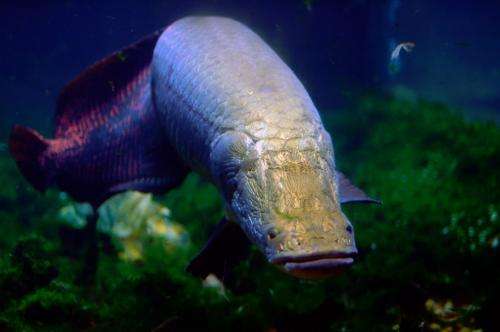Of fish scales and adaptable armor – the things that X-rays can tell you

The remarkably tough scales of a huge air-breathing fresh water fish in the Amazon Basin named "Arapaima gigas" were the subject of a recent study led by Robert Ritchie of Berkeley Lab's Materials Sciences Division and Marc Meyers of the University of California at San Diego. This study generated a swell of media attention that was understandably focused on how arapaima's natural dermal armor allows the fish to swim with impunity through piranha-infested waters. How is it possible for arapaima to survive the razor-sharp teeth and bone-crunching power of piranha jaws that can effortlessly slice through cowhide? Lost in the excitement over the answer Ritchie, Meyers and their collaborators found was the critical role played by the synchrotron X-rays of Berkeley Lab's Advanced Light Source (ALS).
Meyers, a mechanical engineer, launched the study of arapaima's scales in 2011 after a sport fishing trip to Brazil. Measurements by Meyers and his research group revealed that not only could arapaima scale resist piranha bites, it could resist pressure up to 1.7 million pounds per square inch, which is almost double the pressure U.S. nuclear submarine hulls can withstand. Meyers brought his study to the ALS and Ritchie, a leading authority on material strength and toughness.
"Arapaima fish scales consist of a hard, mineralized outer shell surrounding a ductile core composed of collagen fibers arranged in distinct lamellae," Ritchie says. "To study how these scales respond to applied stresses at the molecular level, we used the small angle X-ray scattering facilities at ALS beamline 7.3.3."
In SAXS imaging, beams of X-rays sent through a biological sample are scattered by the proteins within, creating patterns that can be used to characterize the different conformational states assumed by the proteins as sample conditions change. For Ritchie, Meyers and their colleagues, SAXS imaging on ALS beamline 7.3.3 revealed that that the collagen fiber lamellae in the fish scale core are arranged in what Ritchie describes as a "Liberace-type spiral staircase." When subjected to stress, the lamellae in this spiral staircase re-orient themselves to accommodate excess deformation and resist fracturing.

"Under in situ tensile loading in the beamline, most of the lamellae rotate towards the direction of the applied stresses to better resist the applied loads," Ritchie says. "This has the net effect of increasing the toughness of the scale."
Arapaima's fish-scale armor is a prime example of a biological material's evolution for a particular function, specifically to resist the bite of piranhas, Ritchie says. He believes that this unique mechanism of conferring toughness could be mimicked and built into synthetic structural materials to yield enhanced damage tolerance. For example, heavy Kevlar armor used by the U.S. military and police officers could be replaced with armor that would be every bit as effective but much lighter in weight.
"The ability of arapaima's scales to resist predatory attacks derives from its sophisticated structure from the nano- to macro-length-scales," Ritchie says. "The amazing thing shown by our ALS study is that these scales can re-orient themselves in real time to resist force. In essence, it's an adaptable body armor."
A paper describing this research has been published in Nature Communications." The paper is titled "Mechanical adaptability of the bouligand-type structure in natural dermal armour." Ritchie and Meyers are the corresponding authors. Other authors are Elizabeth Zimmermann, Bernd Gludovatz, Eric Schaible, Neil Dave and Wen Yang.
Journal information: Nature Communications
Provided by Lawrence Berkeley National Laboratory




















